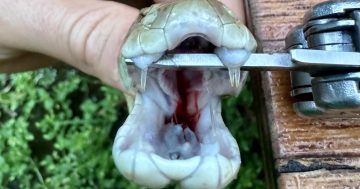
James Cook University researchers have discovered a new species of gecko endemic to Cape York. Photo: Anders Zimny
Scientists have discovered a new reptile stalking the nights across northern Cape York, hunting and eating its prey and even venturing into houses.
It might sound scary, but the animal James Cook University researchers discovered is only around 5cm long, with a pretty zizag pattern that gave it its name.
The Cape York Zigzag Gecko (Amalosia capensis) is widespread from Musgrave north in dry forests, and was recently discovered to be a separate species by JCU Townsville Associate Professor Conrad Hoskin.

James Cook University researchers have discovered a new species of gecko endemic to Cape York. Photo: Stephen Zozaya
“They are really pale and small and just look different then when we looked at the body size and shape, and is really genetically different to other zigzag geckos,” Mr Hoskin said.
“What tipped me off in the wild was its distinctive small size and lovely yellowish colour to its tail.
“Even though I had already picked it in the wild, the genetics really is a bit of a clincher to really justify what we already thought.”
Mr Hoskin and his colleagues also discovered four other new zigzag gecko species, named for the pattern on their backs, but Amalosia capensis is the only one that is found only in remote Cape York.
“I don’t think it’s particularly rare, but it can be a tricky one to find,” Mr Hoskin said.
“It’s pretty much all through that landscape from Musgrave north in the dryer forests all the way to the Tip, basically the top one third of the Cape.”
Mr Hoskin said locals and visitors to the Cape would likely have seen the geckos, possibly even in their homes, but unless they knew what they were looking for, probably didn’t differentiate from other native species or the prolific invasive Asian house gecko.
“It’s not going to be the typical one you see in your house, unfortunately the one that is now most common in houses is the invasive Asian house gecko,” he said.
“When you’re hearing that typical ‘click, click, click’ gecko call, that’s the introduced one, but it does look quite similar to the native one.”
The Cape York Zigzag Gecko has a slender body, reaching about 5cm in length, with copper coloured eyes and the distinctive pale, dark-edged zigzag pattern on its back.











